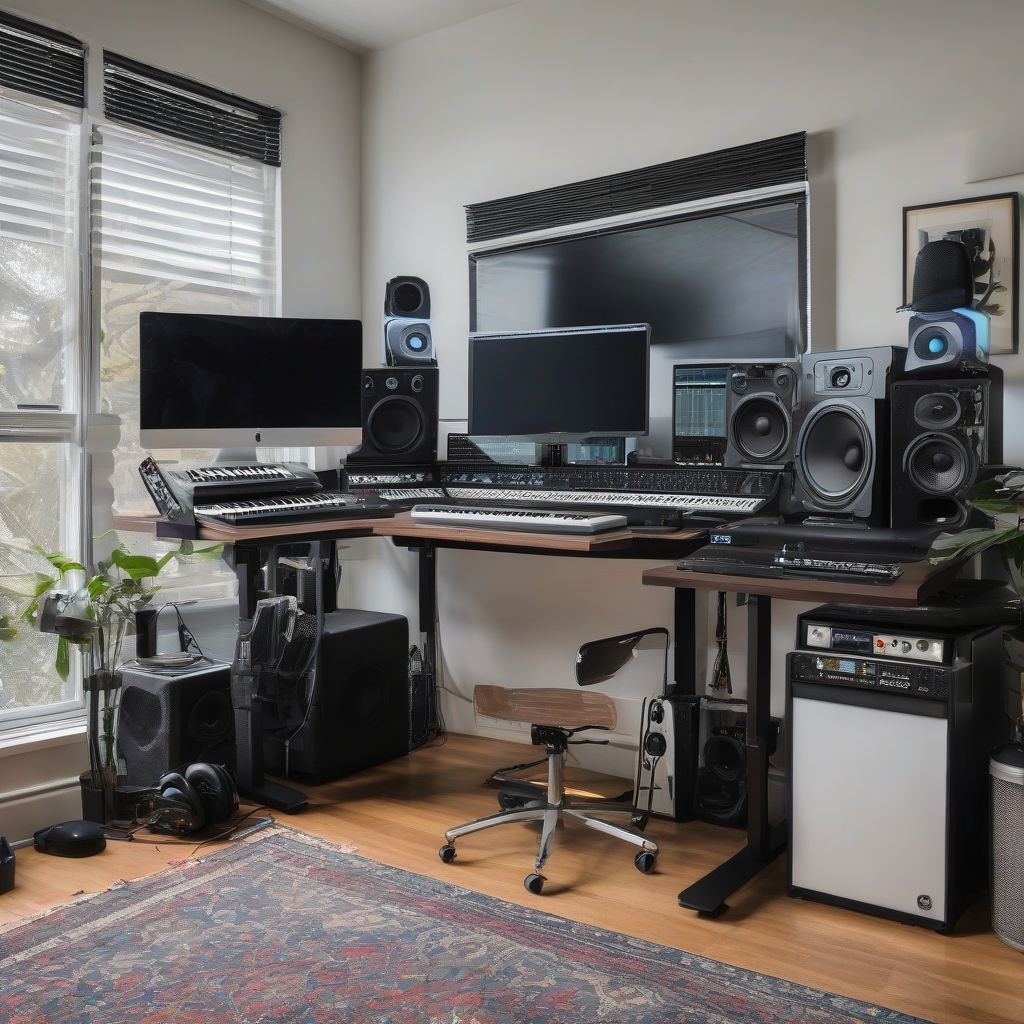Ever feel like you spend more time organizing files than actually making music? You’re not alone. A smooth workflow is like having a well-organized kitchen – it allows creativity to flow and delicious tracks to be served up without a hitch. Whether you’re a seasoned producer or just starting out, these tips will help you optimize your process and unlock a world of musical possibilities.
1. Set Up Your Studio for Success
 Organized Music Studio
Organized Music Studio
A cluttered workspace can lead to a cluttered mind. Start by decluttering your physical and digital workspace. Organize cables, position your monitors ergonomically, and create a system for file management. Consider using a DAW (Digital Audio Workstation) that suits your workflow style.
Choose the Right DAW
Your DAW is your command center. Experiment with different options and find one that feels intuitive and empowers your creative flow. Ableton Live is known for its session view, making it great for loop-based music, while Logic Pro X offers a vast sound library and a linear workflow ideal for recording live instruments.
Invest in a Comfortable Chair and Headphones
It might seem trivial, but trust me, back pain is not conducive to creativity. Invest in a good quality, ergonomic chair and headphones that offer comfort for long hours.
2. Master Your Tools
Knowing your tools inside-out saves you time and frustration. Spend time exploring all the features of your DAW, plugins, and virtual instruments. Watch tutorials, read manuals, and experiment with different sounds and effects.
Build a Go-To Plugin Collection
A vast plugin library can be overwhelming. Instead, curate a collection of essential plugins that you know and love – a versatile EQ, compressor, reverb, delay, and a few instruments that inspire you. This way, you’ll spend less time searching and more time creating.
3. Develop a Consistent Workflow
Just like a chef follows a recipe, having a consistent workflow provides structure and efficiency.
Establish a Pre-Production Ritual
Before diving into a new track, spend time sketching out ideas. This could involve jotting down melodies, experimenting with chord progressions, or even just jamming freely to spark inspiration.
Define Your Tracks with Color Coding and Naming Conventions
A well-organized project is a joy to work with. Use color-coding to differentiate instrument groups, and establish a clear naming convention for tracks and files to prevent confusion later on.
Embrace Templates
Create templates for different genres or project types. This saves time on setting up basic tracks, routing, and effects, allowing you to jumpstart your creative process.
4. The Power of Batch Processing
Batch processing is a time-saving technique that allows you to apply the same process to multiple audio files simultaneously.
Editing and Mixing Efficiency
Imagine cleaning up noise on multiple vocal tracks or applying your favorite mastering chain to several songs with just a few clicks. This is the magic of batch processing.
5. The Art of Effective Sampling
Sampling can be a fantastic way to inject unique character into your music.
Explore Sample Packs and Create Your Own
Numerous online resources offer royalty-free sample packs. However, don’t be afraid to experiment with recording your own sounds to add a personal touch to your tracks.
6. Don’t Underestimate the Importance of Breaks
Stepping away from your music can do wonders for your creativity. Take regular breaks to recharge, listen to reference tracks, and come back with fresh ears.
7. Seek Feedback and Collaboration
Sharing your work with fellow musicians can provide valuable insights and spark new ideas. Join online communities, participate in feedback groups, or collaborate with other artists to push your boundaries.
8. Embrace the Learning Curve
The world of music production is ever-evolving. Embrace the learning process, stay curious, and never stop exploring new techniques, plugins, and sounds.
Conclusion
Improving your workflow in music production is an ongoing journey. By implementing these tips and finding what works best for you, you’ll create a smoother, more efficient, and ultimately, more enjoyable creative experience. Remember, the goal is to remove obstacles, allowing your creativity to flow freely and your music to shine through.
Now, go make some music! Share your thoughts and experiences in the comments below. I’d love to hear about your own workflow tips and tricks.
[amazon bestseller=”music production”]
